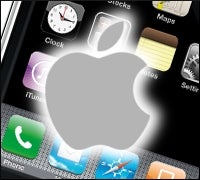 |
What’s Apple got up its sleeve for the iPhone? Per usual, the company has pressed the mute button when it comes to disclosing any future product plans. But a recently awarded Apple patent on touchscreen devices and persistent buzz around new video features both might shed some light on the next iPhone.
Late last month, the U.S. patent office awarded the company Patent No. 7,479,949, “Touchscreen device, method, and graphical user interface for determining commands by applying heuristics.” It’s a complicated description for a fairly simple concept: interacting with a touchscreen and moving through lists on it by using your fingers.
But it’s unclear whether Apple (NASDAQ: AAPL) will wield its new patent to ward off a growing number of rivals who are seeking to capitalize on the iPhone’s booming popularity with touchscreen features of their own. Instead, some industry observers say that Apple might be content to continue beating them in the marketplace — a task that might be made easier thanks to a widely expected injection of videoconferencing and video-capture features into its bestselling device.
Apple did not respond to a request for comment.
The scrutiny over Apple’s next moves comes at a time when competitors in the mobile device market are scrambling to catch up to Apple’s innovative iPhone. Palm drew a lot of buzz at last month’s Consumer Electronics Show
when it showed off the Pre, its next-generation smartphone considered a likely iPhone challenger and due to ship in summer.
It’s a closely watched debut, in part because like the iPhone, the Pre sports a touchscreen interface that supports “multitouch” — the ability to simultaneously use more than one finger to manipulate images on the screen. That feature also happens to be a key component in Apple’s recent patent, the latest of many it’s been granted or has pending related to the iPhone.
Is a showdown brewing between Apple and rivals over multitouch? One patent attorney who’s examined Apple’s newest patent said it would give the company “unbelievable market power” if it stood up to a court challenge.
“What they’re really patenting is the concept of using your fingers on the touchscreen in a particular way,” said Jerrold Spiegel, who heads the technology practice at New York law firm Frankfurt Kurnit Klein & Selz. “It could be a huge asset for them.”
Yet Spiegel wasn’t convinced Apple had a lock on the concept.
“I have concerns about whether it would stand up to a court challenge,” Spiegel told InternetNews.com. “If something’s too obvious, it’s not patentable … That’s why there was such an uproar over One-Click,” he said, referring to Amazon’s controversial patent for single-click online purchasing.
It’s unclear how Apple plans to use its new patent. During its recent first quarter earnings call, Apple’s acting CEO, Tim Cook, said the company is ready to battle any competition through the marketplace. While not addressing Palm specifically, he also noted his company’s patent arsenal, however.
“We will not stand for having our intellectual property ripped off, and we’ll use whatever weapons we have at our disposal,” he said.
Page 2: Palm’s prospects, and will video come to the iPhone?
Page 2 of 2
But Palm doesn’t see itself as much of a pushover.
“Palm has a long history of innovation that is reflected in our products and robust patent portfolio, and we have long been recognized for our fundamental patents in the mobile space,” the company said in a statement sent to InternetNews.com. “If faced with legal action, we are confident that we have the tools necessary to defend ourselves and we have every reason to believe that our launch plans will come to full fruition.”
Ben Bajarin, an analyst at Creative Strategies, said Palm itself has plenty of patents related to its line of mobile devices. “I’ve heard from people inside Palm that they are very confident they can defend their mobile [intellectual property],” Bajarin told InternetNews.com.
Video finally?
But the battle for smartphone dominance may be decided outside of the courtroom, with Apple also widely expected to add new features to the iPhone.
Analysts and iPhone watchers say Apple is almost certain to enhance the product’s next version with video features that could be out as soon as this summer, or announced in time for the company’s next major developer conference in June.
“There has been a lot of pent-up demand for video capture and input, it’s very important,” Bajarin said. “It’s logical to think the next iPhone will have beefed-up storage and memory, GPU and the optics to capture video.”
Raven Zachary, a consultant who specializes in iPhone application development, thinks Apple will generate a lot of excitement if it adds video capture to the iPhone. “I assume that’s on Apple’s short list,” he said. But he’s less enthusiastic about video conferencing.
“I’m not sure I see the practicality of videoconferencing on a phone — it’s more of a novelty,” he said. “I think a lot of people have privacy concerns, and personally, I would rather do audio. Even on the desktop, I rarely use iChat video.”
Industry analyst Roger Kay said he hopes Apple remains willing to explore innovative new designs for the next iPhone. He said he would like to see a device with a larger surface for viewing documents and video, but admits anything that doesn’t fit your pocket is “kind of a Bermuda Triangle of form factors” that
consumers might not like.
Whatever Apple’s next steps, the high end of the mobile device market is theirs to lose, Shiv Bakhshi, an analyst with IDC, told InternetNews.com.
“Apple today is in the driver’s seat. They don’t have to play a lot of catch up with anyone and they’re cool quotient is head and shoulders above anyone else,” Bakhshi said. “Adding more video capabilities is a natural extension of the device, but then you have other issues to support it, like improved battery life — that’s an industry problem.”


